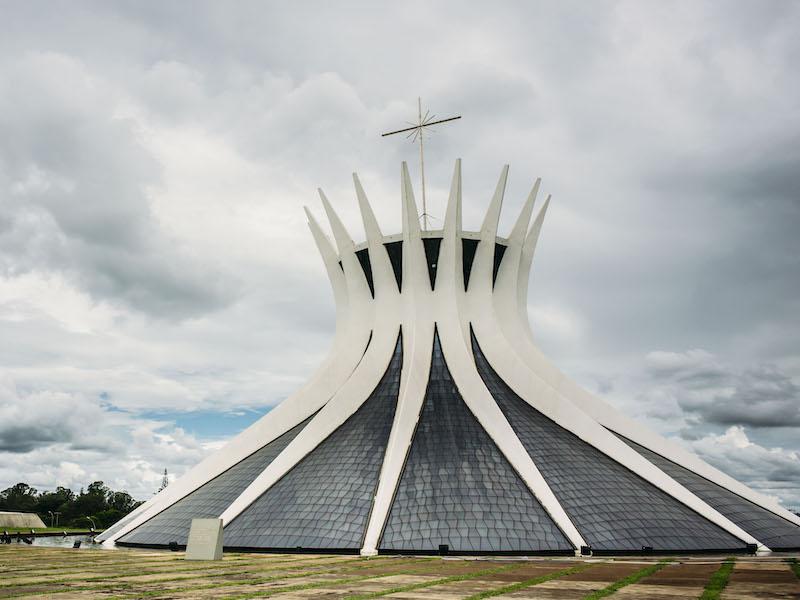Oscar Niemeyer: The Architect Who Invented Brasília

The pioneer of Brazil's modern architecture
Whether in Rio de Janeiro, Belo Horizonte, Brasília or Curitiba, in many places during a Brazil trip you can encounter buildings designed by the famous Brazilian architect Oscar Niemeyer. He is often described as the pioneer of modern Brazilian architecture. Few have the good fortune to live longer than an entire era and thus be direct observers of the changes within that era. Oscar Niemeyer was one of these few protagonists, one of the most revolutionary and durable architects of the 20th century. In the 104 years of his life, he succeeded in leaving an indelible "sign" all over the world.
He was born in Brazil in 1907 and has been associated with the modern movement of architecture since the 1930s. In Latin America, it has adopted a style all its own, which was certainly influenced by the political-ideological context. Niemeyer was a pioneer of modern Brazilian architecture, combining usefulness and poetry. He used a futuristic and sculptural language of forms in which he incorporated many curves and soft contours. The relationship between free space and volume was also always balanced. Early on he used almost exclusively reinforced concrete as a building material. However, his works never lost their functionality, as it was normal in the works of the great masters, such as Le Corbusier.
The beginnings of an international career
Great stories can begin by chance, just being in the right place at the right time. The young Niemeyer enrolled at the Escola Nacional de Belas Artes in Rio de Janeiro and graduated as an engineer and architect in 1934. There he met Lúcio Costa, a representative of the modern Brazilian movement. After his studies, he began working in the studio shared by Lúcio Costa and Carlos Leão.
In 1935, a unique opportunity presented itself: the competition for the Ministry of Education and Health in Rio de Janeiro and the execution of the project was entrusted to their company. The government appointed Le Corbusier, an influential Swiss-French architect, as a consultant to work with the local group of designers, including Niemeyer, who took over as head of the team in 1939. This is one of the first concrete implementations of modern architecture in a building that incorporates all the classic elements of the modern movement: the Pilotis (pillar construction), the garden roof, the Pan de Verre (glass wall), the Brise-Soleil (a kind of sunscreen), a functional skyscraper that makes the most of the surrounding land and the large public spaces inserted under the building.
The story of the Brazilian architect continues over the next two decades with increasingly important commissions such as the Brazilian pavilion at the New York World Expo and later the headquarters of the United Nations: finally an international audience for the Brazilian interpretation of European modernism.
In 1942 and 1943, at the invitation of Mayor Juscelino Kubitschek de Oliveira, he built the Ensemble of Modernism in Pampulha, a suburb of Belo Horizonte. Among them is the Church of St. Francis of Assisi, which the ecclesiastical authorities did not want to consecrate until 1959 because of its innovative forms.
"I am not attracted to straight angles or to the straight line, hard and inflexible, created by man. I am attracted to free-flowing, sensual curves. The curves that I find in the mountains of my country, in the sinuousness of its rivers, in the waves of the ocean and on the body of the beloved woman. Curves make up the entire universe, the curved universe of Einstein." Oscar Niemeyer, 1996
Brasília - Niemeyer's most famous project
But it was only with the founding of Brasília, the new capital of Brazil, which was built in only four years between 1956 and 1960 in the interior of Brazil, that the myth of Brazilian technical-industrial progress merged with architecture and urban planning. Juscelino Kubitschek de Oliveira, who was elected president of the country in the meantime, commissioned Niemeyer to organize a competition for the construction of the new city of Brasília. Lúcio Costa's project was the winner and so Oscar Niemeyer's old friend drew the city plan while he designed the buildings of the most important institutions: the Presidential Palace, the Supreme Court and Congress, some ministries and the extraordinary cathedral.
In 1964, two years after the military seized power, Niemeyer went into exile in France because of his membership in the Brazilian Communist Party. Even during his time in exile, he designed new works, such as the Mondadori publishing house in Milan, the headquarters of the Communist Party in Paris and the House of Culture in Le Havre. He was able to continue his work in Brazil towards the end of the 1960s, also teaching at the University of Rio de Janeiro. But only in the 1980s, he was able to return completely to Brazil.
Oscar Niemeyer has designed buildings and projects throughout his life without interruption, maintaining the connection to his most visionary project: Brasília. In 1987, the modern capital Brasília was declared a World Heritage Site by UNESCO.
If you would like to learn more about the Brazilian architect, his life and his works, watch the documentary film "Oscar Niemeyer - Life is a breath of fresh air" (original title: "Oscar Niemeyer - A vida é um sopro"). Or, during your next vacation in Brazil, you can stop in the Brazilian capital and take a closer look at his works.
Sources: www.architekt.de, www.floornature.de, www.niemeyer.org.br, www.wikipedia.org

